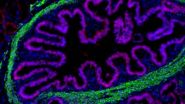Viagra protects the heart beyond the bedroom
2014-10-20
(Press-News.org) Viagra could be used as a safe treatment for heart disease, finds new research published today in the open access journal BMC Medicine. The study reveals that long-term daily treatment of Viagra can provide protection for the heart at different stages of heart disease, with few side effects.
Phosphodiesterase-5 inhibitor (PDE5i) is the main ingredient in Viagra and other drugs commonly used to treat erectile dysfunction. The inhibitor blocks the enzyme PDE5, which prevents relaxation of smooth muscle tissue. The presence of PDE5 in the heart has led to previous research on whether the inhibitor could treat non-urological conditions. But despite some promising results, the studies were largely based on animals and the cardioprotective effects of PDE5i remained unclear.
Scientists from the Sapienza University of Rome carried out a meta-analysis of randomized controlled trials by searching for articles published between January 2004 and May 2014 to test the effectiveness of PDE5i in providing cardiac protection, and to find out whether it was well-tolerated and safe. They identified 24 suitable trials for analysis from four research databases: MEDLINE, EMBASE, Cochrane Library and SCOPUS. The trials involved 1622 patients from mixed populations who were treated with PDE5i or a placebo.
For the first time, the scientists conducted a parallel analysis of the effects of the inhibitor on the size and shape of the heart and its performance.
The analysis shows that PDE5i prevented the heart increasing in size and changing shape in patients suffering from left ventricular hypertrophy, a condition which causes thickening of the muscles in the left ventricle. The inhibitor also improved heart performance in all patients with different heart conditions, with no negative effect on the patients' blood pressure.
Lead author of the study, Andrea Isidori said: "We found that the main ingredient in Viagra can be used as an effective, safe treatment for several patients with heart disease. Large clinical trials are now urgently needed to build on these encouraging findings."
The study concludes that the inhibitor could be reasonably administered to men who suffer from heart muscle thickening and early-stage heart failure. However, since most of the studies included in the meta-analysis were on men, the researchers suggest the next step should be a larger trial on sex-specific long-term responses.
INFORMATION:
Media Contact
Ruth Francis
Head of Communications
BioMed Central
T: +44 (0)20 3192 2737
M: +44 (0)78 2528 7546
E: Ruth.Franicis@biomedcentral.com
Notes to editor:
1. Research article
Is Chronic Inhibition of Phosphodiesterase type 5 Cardioprotective and Safe? A Meta-Analysis of Randomized Controlled Trials
Elisa Giannetta, Tiziana Feola, Daniele Gianfrilli, Riccardo Pofi, Valentina Dall'Armi, Roberto Badagliacca, Federica Barbagallo, Andrea Lenzi and Andrea M. Isidori
BMC Medicine 2014, 12:185
After embargo, article available at journal website here:
http://www.biomedcentral.com/1741-7015/12/185
Please name the journal in any story you write. If you are writing for the web, please link to the article. All articles are available free of charge, according to BioMed Central's open access policy.
2. BMC Medicine is the flagship medical journal of the BMC series, publishing original research, commentaries and reviews that are either of significant interest to all areas of medicine and clinical practice, or provide key translational or clinical advances in a specific field.
3. BioMed Central is an STM (Science, Technology and Medicine) publisher which has pioneered the open access publishing model. All peer-reviewed research articles published by BioMed Central are made immediately and freely accessible online, and are licensed to allow redistribution and reuse. BioMed Central is part of Springer Science+Business Media, a leading global publisher in the STM sector. http://www.biomedcentral.com
ELSE PRESS RELEASES FROM THIS DATE:
2014-10-20
The findings suggest that this disturbing trend could be due the emergence of more virulent group B streptococcal strains and call for a renewed evaluation of preventive strategies to reduce neonatal disease.
Passed from mother to child during birth, group B streptococcus is the most common cause of infection in newborns. Guidelines for the prevention of disease have been widely adopted in high-income countries. But despite these efforts, the bacterium remains a leading cause of blood stream infections and meningitis worldwide, typically affecting babies younger than ...
2014-10-19
BETHESDA, MD – Breaking down complex conditions such as Type 2 Diabetes and obesity into the specific metabolic proteins and processes that underlie them offers a new approach to studying the genetics of these diseases and how they are interrelated, according to research presented today at the American Society of Human Genetics (ASHG) 2014 Annual Meeting in San Diego.
By studying specific proteins that contribute to such conditions – and the genes that encode them – scientists can develop new drugs that directly target the metabolic processes that do ...
2014-10-19
Improving household electricity access in India over the last 30 years contributed only marginally to the nation's total carbon emissions growth during that time, according to a new study published in the journal Nature Climate Change.
"Energy access is fundamental to development: it brings improvements to all aspects of life, including education, communication, and health," says IIASA researcher Shonali Pachauri, who conducted the study.
While increased energy access is widely agreed to be an important goal for development efforts, such as the UN Sustainable Energy ...
2014-10-19
VIDEO:
Michael Helmrath, M.D., M.S., surgical director of the Intestinal Rehabilitation Program at Cincinnati Children's Hospital Medical Center, talks about researchers successfully growing human intestinal tissue in mice. The study describes...
Click here for more information.
CINCINNATI --Researchers have successfully transplanted "organoids" of functioning human intestinal tissue grown from pluripotent stem cells in a lab dish into mice – creating an unprecedented ...
2014-10-19
DNA has garnered attention for its potential as a programmable material platform that could spawn entire new and revolutionary nanodevices in computer science, microscopy, biology, and more. Researchers have been working to master the ability to coax DNA molecules to self assemble into the precise shapes and sizes needed in order to fully realize these nanotechnology dreams.
For the last 20 years, scientists have tried to design large DNA crystals with precisely prescribed depth and complex features – a design quest just fulfilled by a team at Harvard's Wyss Institute ...
2014-10-19
AMHERST, Mass. ¬– The claim by microbiologist Derek Lovley and colleagues at the University of Massachusetts Amherst that the microbe Geobacter produces tiny electrical wires, called microbial nanowires, has been mired in controversy for a decade, but the researchers say a new collaborative study provides stronger evidence than ever to support their claims.
UMass Amherst physicists working with Lovley and colleagues report in the current issue of Nature Nanotechnology that they've used a new imaging technique, electrostatic force microscopy (EFM), to resolve ...
2014-10-19
Berlin, 19th October 2014 What's in a name? Doctors have found that the name of the drug you are prescribed significantly influences how the patient sees the treatment. Now in a significant shift, the world's major psychiatry organisations are proposing to completely change the terminology of the drugs used in mental disorders shifting it from symptom based (e.g. antidepressant, antipsychotic etc.) to pharmacologically based (e.g. focusing on pharmacological target (serotonin, dopamine etc.) and the relevant mode of action). This will mean that patient will no longer have ...
2014-10-19
Scientists at The University of Manchester hope a major breakthrough could lead to more effective methods for detoxifying dangerous pollutants like PCBs and dioxins. The result is a culmination of 15 years of research and has been published in Nature. It details how certain organisms manage to lower the toxicity of pollutants.
The team at the Manchester Institute of Biotechnology were investigating how some natural organisms manage to lower the level of toxicity and shorten the life span of several notorious pollutants.
Professor David Leys explains the research: ...
2014-10-19
Kansas City, MO - While megakaryocytes are best known for producing platelets that heal wounds, these "mega" cells found in bone marrow also play a critical role in regulating stem cells according to new research from the Stowers Institute for Medical Research. In fact, hematopoietic stem cells differentiate to generate megakaryocytes in bone marrow. The Stowers study is the first to show that hematopoietic stem cells (the parent cells) can be directly controlled by their own progeny (megakaryocytes).
The findings from the lab Stowers Investigator Linheng Li, Ph.D., described ...
2014-10-19
At least 2 percent of people over age 40 and 5 percent of people over 70 have mutations linked to leukemia and lymphoma in their blood cells, according to new research at Washington University School of Medicine in St. Louis.
Mutations in the body's cells randomly accumulate as part of the aging process, and most are harmless. For some people, genetic changes in blood cells can develop in genes that play roles in initiating leukemia and lymphoma even though such people don't have the blood cancers, the scientists report Oct. 19 in Nature Medicine.
The findings, based ...
LAST 30 PRESS RELEASES:
[Press-News.org] Viagra protects the heart beyond the bedroom




